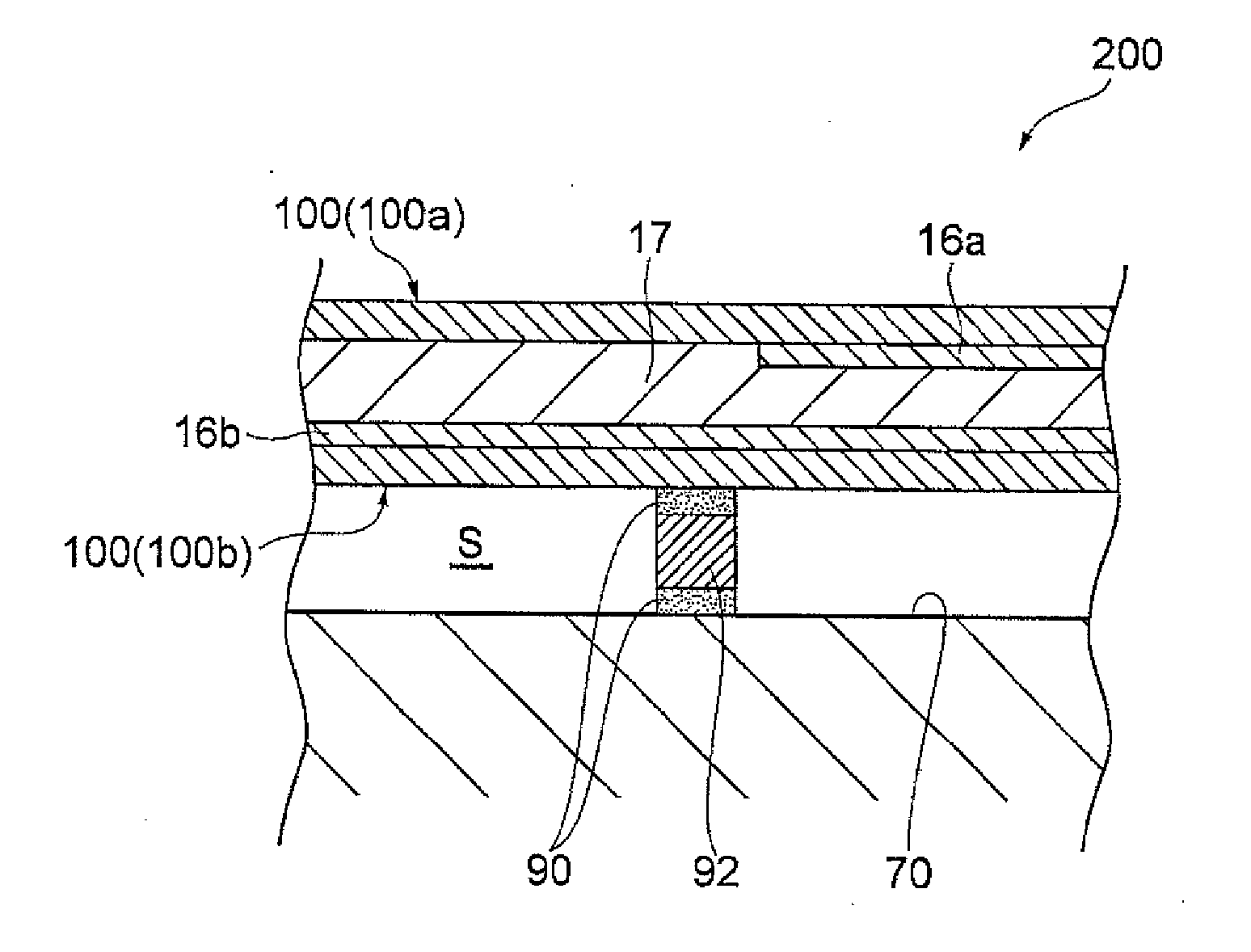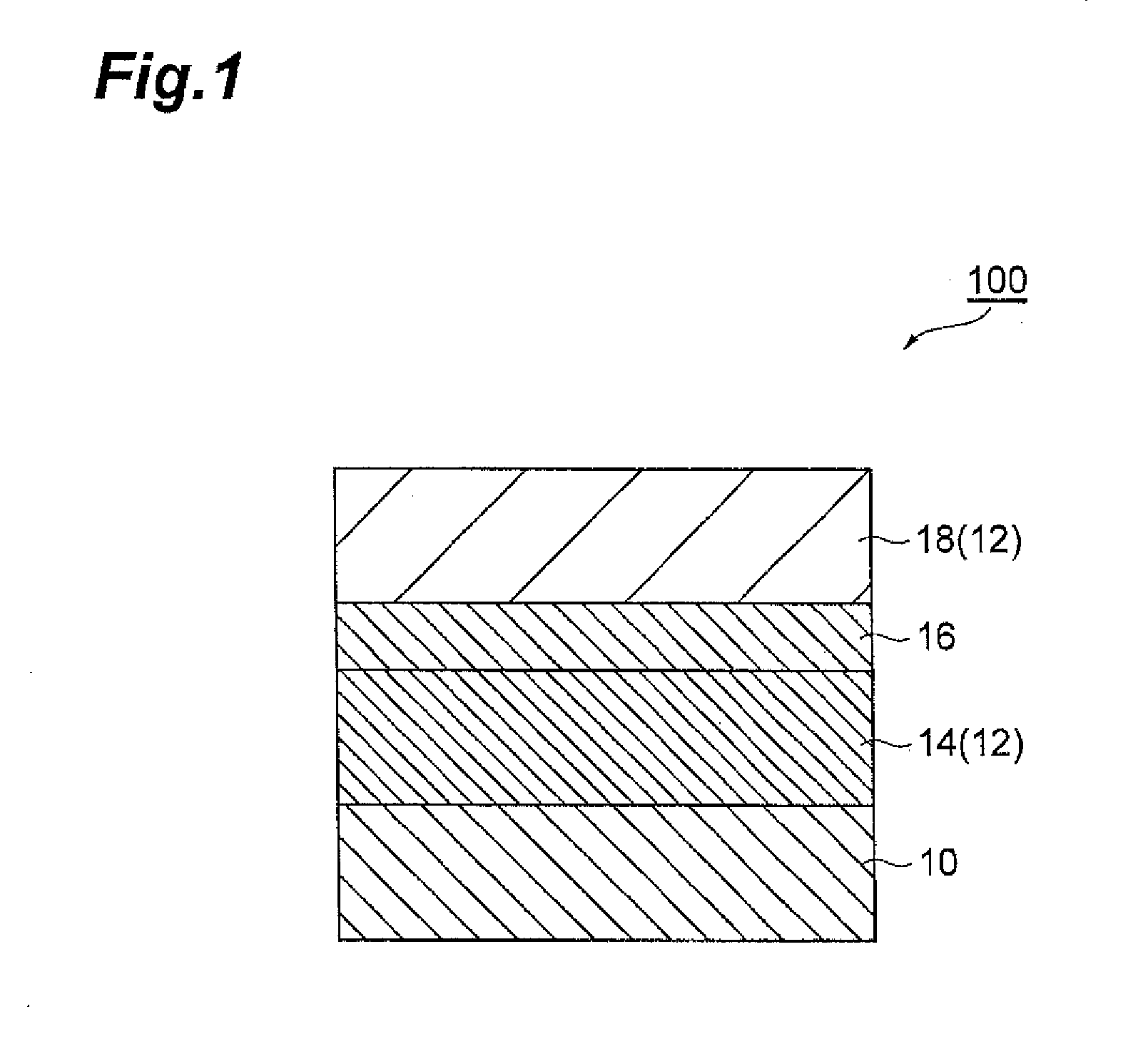Transparent conductor and touch panel
a transparent conductor and touch panel technology, applied in the field of transparent conductors and touch panels, can solve the problems of difficult thermal annealing at a high temperature, difficult preparation of zn—sn—o oxide films or films, and difficult resistance of film substrates, etc., to achieve excellent storage reliability, clear display, and low surface resistance
- Summary
- Abstract
- Description
- Claims
- Application Information
AI Technical Summary
Benefits of technology
Problems solved by technology
Method used
Image
Examples
production example 1
Production of Transparent Conductor 101
[0084]A transparent conductor 101 as shown in FIG. 3 was produced. The transparent conductor 101 had a multilayer structure in which a second hard coat layer 24, a transparent substrate 10, a first hard coat layer 22, a first metal oxide layer 14, a metal layer 16, and a second metal oxide layer 18 were stacked in this order. The transparent conductor 101 was produced by the following procedure.
[0085]A polyethylene terephthalate film (manufactured by Toray Industries Inc., product number: U48) having a thickness of 100 μm was prepared. This PET film was used as the transparent substrate 10. A coating material for forming the first hard coat layer 22 and the second hard coat layer 24 was prepared by the following procedure. First, the following raw materials were prepared.
[0086]Reactive group-modified colloidal silica (dispersion medium: propylene glycol monomethyl ether acetate, nonvolatile content: 40% by weight): 100 parts by weight
[0087]Dipe...
production example 2
[0099]In the same manner as in Production Example 1, on the first hard coat layer 22, a first metal oxide layer 14, a metal layer 16, and a second metal oxide layer 18 were sequentially formed by DC magnetron sputtering, giving samples 8 to 14 of the transparent conductor 101. In Production Example 2, γ was changed in a range of 0 to 30% by mole where the Al2O3—ZnO—SnO2—Ga2O3 target had a composition ratio of [(Al2O3—ZnO)95(SnO2)5]100-γ(Ga2O3)γ. Here, the ratio of Al2O3, α, was fixed at 2% by mole.
[0100]The compositions of the first metal oxide layer 14 and the second metal oxide layer 18 in Production Example 2 are as shown in Table 2. The compositions of the first metal oxide layer 14 and the second metal oxide layer 18 in Production Example 2 are indicated with open circles in the ternary diagram of FIG. 2. Each sample in Production Example 2 was evaluated in the same manner as in Production Example 1. Table 2 shows the results.
TABLE 2Sample 8Sample 9Sample 10Sample 11Sample 12Sa...
production example 3
[0102]In the same manner as in Production Example 1, on the first hard coat layer 22, a first metal oxide layer 14, a metal layer 16, and a second metal oxide layer 18 were sequentially formed by DC magnetron sputtering, giving samples 15 to 21 of the transparent conductor 101. In Production Example 3, γ was changed in a range of 0 to 30% by mole where the Al2O3—ZnO—SnO2—Ga2O3 target had a composition ratio of [(Al2O3—ZnO)90(SnO2)10]100-γ(Ga2O3)γ. Here, the ratio of Al2O3, α, was fixed at 2% by mole.
[0103]The compositions of the first metal oxide layer 14 and the second metal oxide layer 18 in Production Example 3 are as shown in Table 3. The compositions of the first metal oxide layer 14 and the second metal oxide layer 18 in Production Example 3 are indicated with triangles in the ternary diagram of FIG. 2. Each sample in Production Example 3 was evaluated in the same manner as in Production Example 1. Table 3 shows the results.
TABLE 3Sample 15Sample 16Sample 17Sample 18Sample 19S...
PUM
| Property | Measurement | Unit |
|---|---|---|
| Percent by mole | aaaaa | aaaaa |
| Transparency | aaaaa | aaaaa |
Abstract
Description
Claims
Application Information
 Login to View More
Login to View More - R&D
- Intellectual Property
- Life Sciences
- Materials
- Tech Scout
- Unparalleled Data Quality
- Higher Quality Content
- 60% Fewer Hallucinations
Browse by: Latest US Patents, China's latest patents, Technical Efficacy Thesaurus, Application Domain, Technology Topic, Popular Technical Reports.
© 2025 PatSnap. All rights reserved.Legal|Privacy policy|Modern Slavery Act Transparency Statement|Sitemap|About US| Contact US: help@patsnap.com



